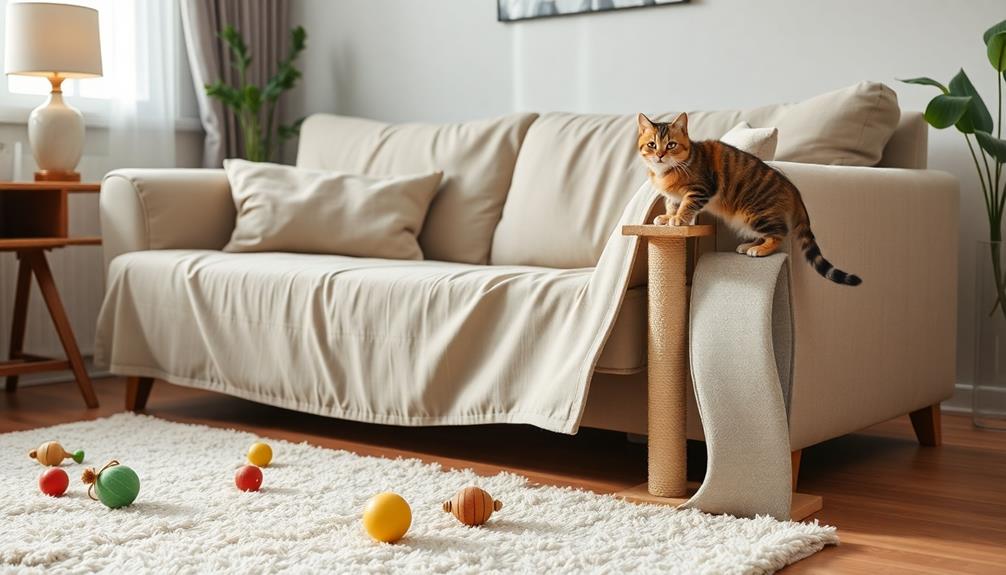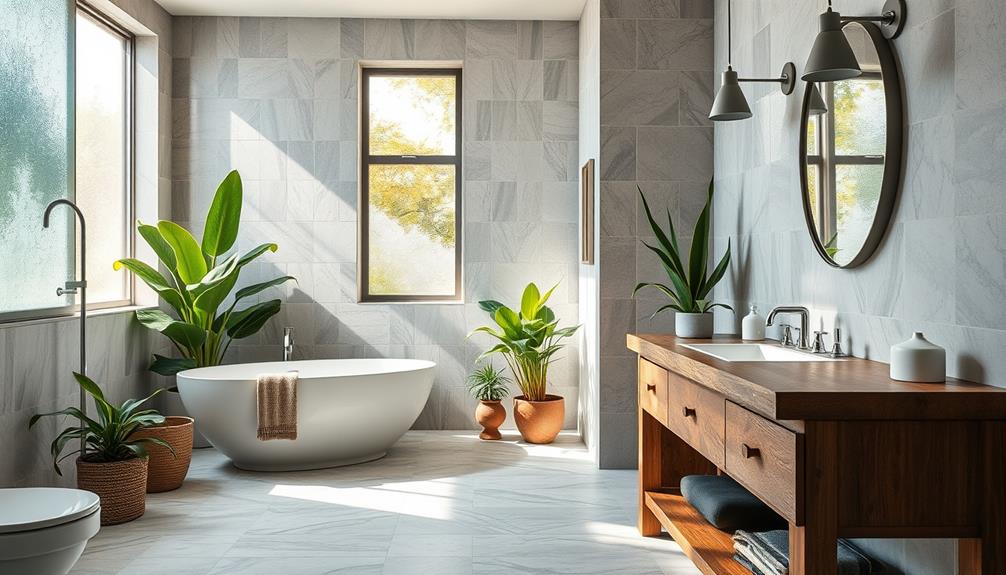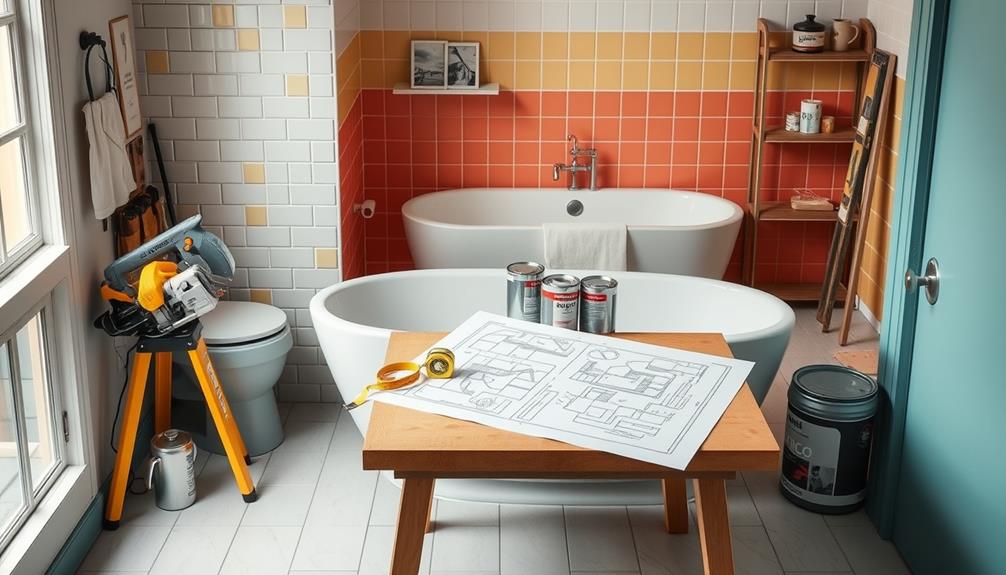In order to protect your furniture from cats, consider starting with the use of durable sofa covers and transparent vinyl guards to cover areas that are susceptible to scratching. It is also helpful to incorporate scratching posts in common areas to redirect their natural instincts, placing them near furniture you want to safeguard. Regular nail trimming can also help minimize damage. Additionally, using double-sided sticky tape or citrus sprays can be effective deterrents. Nail caps are another option for temporary protection. By implementing these strategies, your furniture will be better equipped to resist scratches. There are even more steps you can take to create a harmonious living space for both you and your cat. Providing plenty of toys and interactive activities can help keep your cat mentally and physically engaged, reducing their inclination to scratch furniture out of boredom. Training your cat with positive reinforcement when they use their scratching posts is another effective method for keeping them away from furniture. With patience and consistency, you can establish a cat-friendly environment while protecting your home’s furnishings.
Key Takeaways
- Use durable sofa covers and transparent vinyl guards to protect furniture from cat scratches while maintaining aesthetics.
- Provide scratching posts in common areas to redirect cats from scratching furniture.
- Regularly trim your cat's nails every two to three weeks to minimize potential damage.
- Apply double-sided sticky tape or citrus sprays on furniture surfaces to deter scratching behavior.
- Invest in products like Clawguard Furniture Shields and Soft Claws nail caps for effective protection solutions.
Furniture Protection Strategies
When you want to protect your furniture from your cat's claws, employing effective strategies can make a significant difference. Start by using furniture protectors like durable sofa covers designed to withstand cat claws. These covers come in various colors and patterns, so you won't have to compromise on your home's aesthetic.
You can also apply transparent furniture guards made of vinyl to shield specific areas prone to scratching without disrupting your décor. Additionally, guarantee proper airflow around your furniture to maintain a pleasant environment, similar to how air purifier maintenance helps enhance performance in your home.
Utilizing double-sided sticky tape on furniture surfaces can deter your cat from scratching, as the unpleasant sensation encourages them to seek alternative options.
Additionally, consider incorporating citrus or essential oil sprays as natural deterrents; cats usually dislike these strong smells. Just be sure to test them on inconspicuous areas first.
Providing Alternatives for Scratching

To keep your furniture safe, start by placing scratching posts in areas where your cat loves to hang out.
Offering a mix of vertical and horizontal surfaces can cater to their scratching preferences and help redirect their energy.
Additionally, consider using natural ingredients in homemade cat treats as a reward for using the scratching posts, promoting overall health and wellness for your pet natural ingredients promote health.
Scratching Post Placement
Strategically placing scratching posts can considerably reduce your cat's urge to scratch furniture. Start by positioning scratching posts in common areas where your cat spends the most time. This encourages use and helps redirect scratching behavior away from your beloved furniture.
If your cat tends to scratch a specific piece of furniture, place a scratching post nearby to increase the likelihood of them choosing it over the furniture. Additionally, consider incorporating natural remedies for calming your cat, as consideration of natural remedies can further reduce unwanted scratching behaviors.
Make sure the scratching posts are tall enough—at least 32 inches—to satisfy your cat's natural instinct for vertical scratching. Many cats prefer this type of surface, and a tall post provides them with an enticing option.
Using a variety of scratching post materials, like sisal, cardboard, or carpet, caters to different preferences and keeps them engaged in their scratching activities.
To maintain your cat's interest and prevent boredom, regularly rotate the locations and types of scratching posts. This helps keep their scratching behavior directed towards the designated posts, ultimately protecting your furniture from unwanted damage.
Variety of Scratching Surfaces
Cats love to scratch, and providing a variety of scratching surfaces can help redirect that instinct away from your furniture. To effectively satisfy their scratching needs, consider investing in multiple scratching posts made from appealing materials like sisal rope or cardboard. Offering both vertical posts and horizontal scratching surfaces caters to different preferences, increasing the likelihood that your cat will use them.
Position these scratching posts near your cat's favorite resting spots or areas where they typically scratch. This encourages frequent use and helps them associate these designated areas with positive experiences. Additionally, incorporating scratching mats can enhance the options available. You can place these mats on the floor, drape them over furniture, or attach them to walls, providing versatile scratching opportunities.
To keep your cat engaged, regularly rotate scratching surfaces and introduce new textures. This prevents boredom and maintains their interest in designated scratching areas.
Maintenance and Care Techniques

To keep your furniture safe, regular nail trimming is key; aim for every two to three weeks.
Plus, using positive reinforcement when your cat scratches in the right places can make a big difference in their behavior.
Regular Nail Trimming
Every two to three weeks, you should make nail trimming a part of your cat care routine. Regularly trimming your cat's nails greatly reduces the damage caused by scratching furniture and other surfaces.
Using nail clippers specifically designed for cats guarantees a safe and effective trim. You might also want to use cat nail files or emery boards to keep those nails smooth and prevent snagging.
Maintaining this routine not only protects your furniture but also promotes your cat's overall health. Overgrown nails can lead to discomfort or even injury, making regular trimming essential.
If you have multiple cats, this practice becomes even more important. It helps manage scratching behaviors and reduces the likelihood of territorial disputes over your furniture.
Creating a positive experience around nail trimming can make the process smoother. Consider using positive reinforcement, like treats or praise, to help your cat associate nail trimming with something enjoyable.
Positive Reinforcement Training
Integrating positive reinforcement training into your routine can greatly enhance your efforts to protect furniture from scratching. By rewarding your cat with treats, praise, or affection immediately when they use scratching posts instead of your furniture, you encourage desirable behavior.
Consistency is key—offer rewards every time your cat engages with the appropriate scratching surface.
To attract your cat to scratching posts, consider utilizing catnip or placing treats at the base. These techniques can help redirect their natural instincts away from your furniture.
Regularly monitoring your cat's responsiveness to these training techniques is crucial. Adjust your approach to guarantee that rewards remain meaningful and timely.
Engaging your cat in interactive play sessions can also reduce boredom, decreasing the likelihood of unwanted scratching. Incorporate toys that mimic prey to stimulate their hunting instincts, providing an alternative outlet for their energy.
Over time, this combination of positive reinforcement and engaging activities will help establish new habits, making your home a cat-friendly environment that protects your furniture from scratching.
Engagement and Stimulation

Engaging your cat with interactive toys like feather wands or laser pointers keeps them mentally and physically stimulated, reducing their urge to scratch your furniture.
Regular play sessions not only provide fun but also reinforce proper scratching behavior, steering your cat away from your beloved couch.
To enhance your cat's engagement, consider these strategies:
- Rotate toys every few days to maintain interest and prevent boredom.
- Incorporate cat trees or climbing shelves to satisfy their natural climbing instincts, diverting attention from your furniture.
- Provide various scratching surfaces, including vertical posts and horizontal mats, catering to different preferences and encouraging them to scratch where you want.
- Schedule regular play sessions that integrate scratching alternatives, keeping your cat entertained and less likely to seek out your furniture for stimulation.
Best Products for Furniture Protection
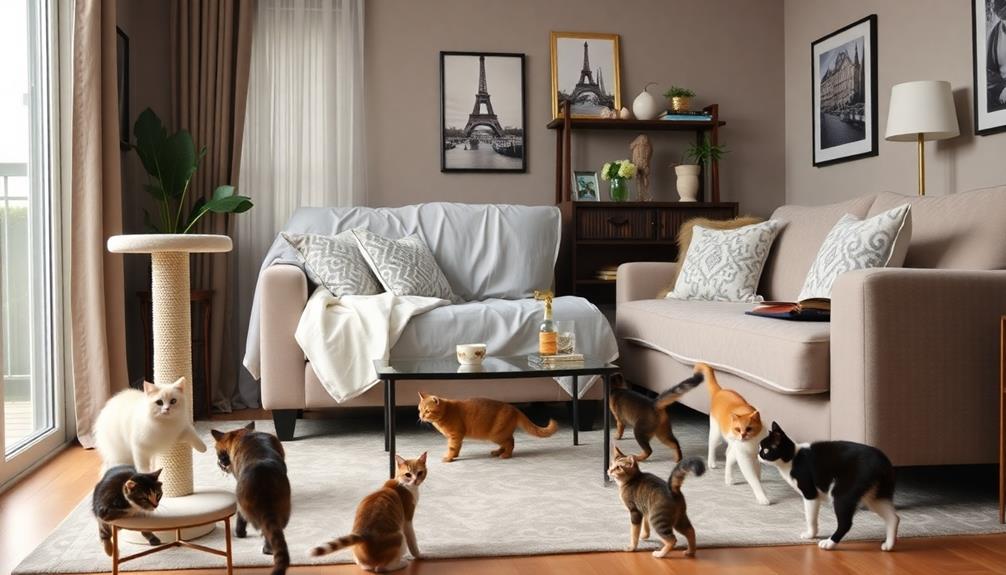
Protecting your furniture from cat scratches can be achieved with the right products designed specifically for this purpose. One effective option is the Clawguard Furniture Shields, which provide durable, transparent protection for your furniture.
They're easy to install using upholstery twist pins and can be trimmed to fit the dimensions of your furniture that your cat is likely to scratch.
For a non-invasive solution, consider Pioneer Pet Sticky Paws. This double-sided tape deters cats from scratching by sticking to surfaces, although you'll need to replace it regularly due to debris.
Another innovative choice is the Sofa Scratcher, which doubles as a scratching post and furniture guard, fitting snugly against your furniture without needing tape or pins.
You might also want to try Soft Claws nail caps for your cat, which allow natural claw extension while protecting your furniture.
Finally, the Our Pets Double-Wide Floor Scratcher caters to both vertical and horizontal scratching preferences, encouraging your cat to use designated areas instead of your furniture.
With these products, you can keep your furniture safe and stylish!
Advantages and Disadvantages of Nail Caps

While nail caps like Soft Claws can be a practical solution for safeguarding your furniture from cat scratches, they come with both benefits and drawbacks. Understanding these can help you decide if they're right for your furry friend.
Advantages:
- Non-destructive solution: Nail caps cover sharp claws, preventing furniture damage without altering your cat's behavior.
- Safe for cats: Made from soft, durable vinyl and applied with non-toxic adhesive, they're generally safe for your pet.
- Natural claw extension: Nail caps allow for natural claw extension, so your cat can still stretch and flex.
- Effective temporary solution: They last about 4 to 6 weeks, making them ideal during training or changing phases.
Disadvantages:
However, there are a few downsides. Some cats may resist wearing them or have difficulty adjusting to the feel.
Additionally, their effectiveness can vary based on individual temperament, and they require consistent monitoring to guarantee they stay in place.
Occasionally, nail caps may fall off prematurely, necessitating careful application and consideration of your cat's activity level.
Ultimately, weigh these pros and cons to find the best solution for your cat and your furniture.
User Experience and Effectiveness
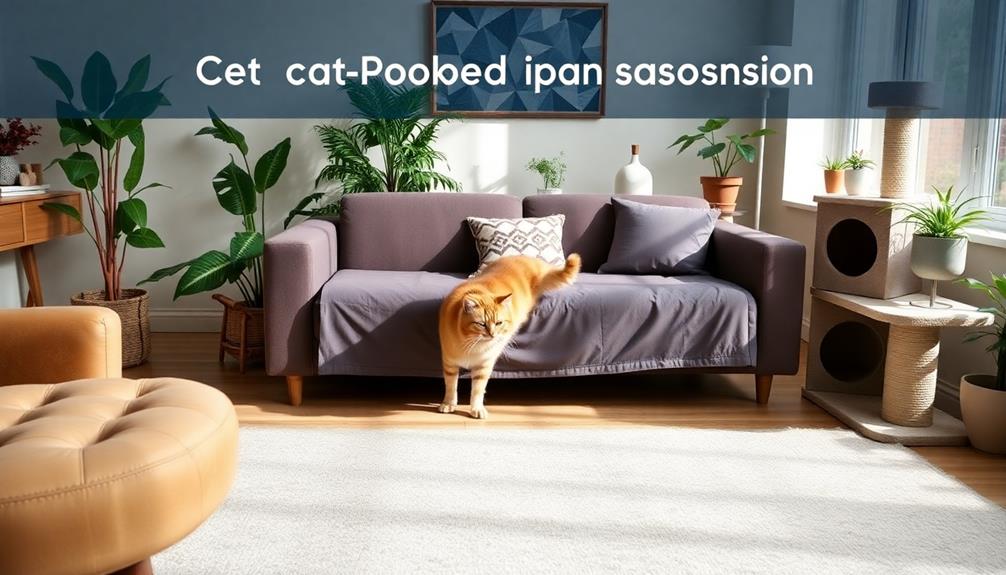
When it comes to protecting your furniture from feline mischief, user experiences highlight the effectiveness of various products designed for this purpose. Many cat owners have found that items like Clawguard Furniture Shields and sofa scratchers greatly reduce scratching damage, with positive results often seen within weeks.
Alternatives such as scratching posts and mats are particularly effective in encouraging your cat to redirect their scratching behavior, leading to less wear and tear on your furniture.
One of the most appreciated features is how easy to apply these products are. Users frequently mention the simplicity of installing double-sided tape or furniture guards without causing damage.
Long-term use of these protective measures typically requires minimal upkeep, making them lasting solutions for safeguarding your belongings.
Another key factor in success is the variety of colors and styles available. This customization allows you to choose products that match your home decor while catering to your cat's preferences, increasing the likelihood of preventing furniture damage.
Considerations and Limitations
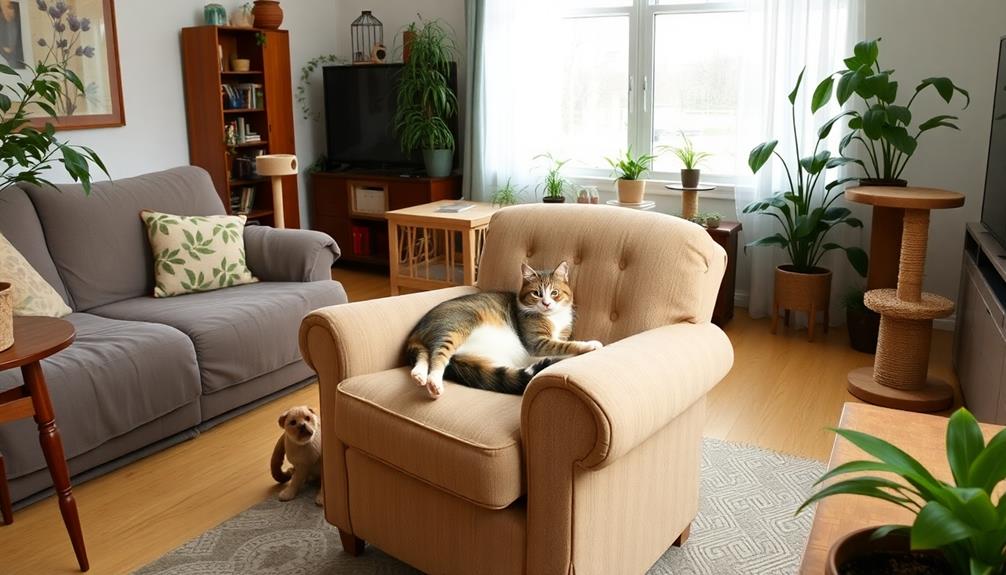
Numerous factors come into play when considering furniture protection from cats, and it's important to weigh the pros and cons before committing to a solution.
Here are some considerations and limitations to keep in mind:
- Cost: Some protection products, like guards or tape, can be pricier than traditional methods, which might strain your budget.
- Installation: Certain items, such as scratching posts or furniture shields, may require time and effort to set up, which can be inconvenient for busy pet owners.
- Aesthetic Appeal: The visibility of guards or tape could impact your furniture's look. Transparent options may not blend seamlessly with every decor style.
- Effectiveness: The success of different methods varies with individual cat behavior. You might need to experiment to find what truly works for your feline friend.
Additionally, regular maintenance is essential.
Products like nail caps or scratching surfaces need replacement every few weeks to continue protecting your sofa effectively.
Product Information and Resources
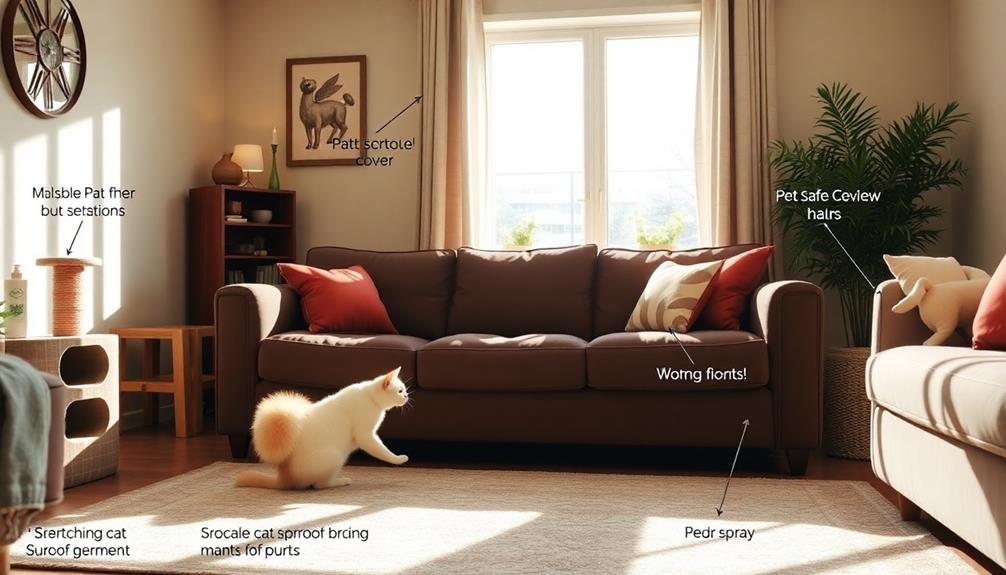
To keep your furniture safe from feline claws, exploring effective products is key. One excellent option is the 12 PCS Anti Cat Scratch Furniture Protector by Fomers.
These protectors come in XXL and XL sizes, measuring 14.65 x 12.01 x 0.59 inches, and are made from non-toxic, durable materials that resist cat claws while blending seamlessly with your furniture's aesthetic.
Installation is easy; simply apply professional sofa glue for strong adhesion on fabric without leaving residue. Plus, the product includes 40 twist pins for added security.
Customer reviews rate it 4.3 out of 5 stars, praising its effectiveness and ease of application. Some users suggest using additional spiral pins over time for enhanced durability.
For a temporary solution while training your cat, consider Soft Paws nail caps. Available in various sizes and colors, these caps can last 4-6 weeks, helping you protect your furniture without hindering your cat's natural behavior.
Additionally, using scratch tape on vulnerable areas can deter scratching. With these products, you can safeguard your furniture effectively while keeping your feline friend happy.
Frequently Asked Questions
How Do I Make My Furniture Cat Proof?
To make your furniture cat-proof, consider using protective covers, applying double-sided tape on vulnerable areas, and providing appealing scratching posts nearby. You'll create a comfortable environment for both you and your feline friend.
How Can I Keep My Cat off My Furniture?
Ever wondered why your cat loves your furniture so much? To keep them off, create enticing alternatives like scratching posts, use deterrents like citrus sprays, and reward them when they choose their designated spots.
How Do I Stop My Cat From Attacking My Furniture?
To stop your cat from attacking furniture, provide scratching posts, use double-sided tape on surfaces, apply citrus sprays, trim their nails regularly, and reward them for choosing the right spots to scratch instead.
What Smell Will Keep Cats off Furniture?
Cats generally dislike citrus, vinegar, and strong essential oils like lavender and peppermint. You can use these scents effectively by spraying diluted solutions on surfaces, ensuring to test them first to avoid any damage.
Conclusion
By combining protective strategies with engaging alternatives, you can create a harmonious home for both you and your cat. Imagine this: as you settle onto your scratch-resistant sofa, your feline friend happily claws at their designated scratching post nearby. It's a win-win—your furniture stays safe, and your cat gets the stimulation they need. With the right products and a little effort, you'll find that protecting your furniture from cats can be both effective and rewarding.
